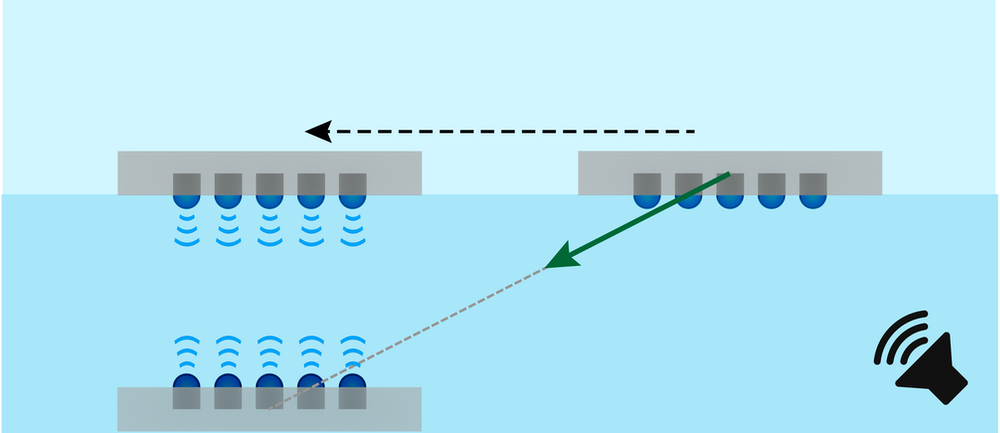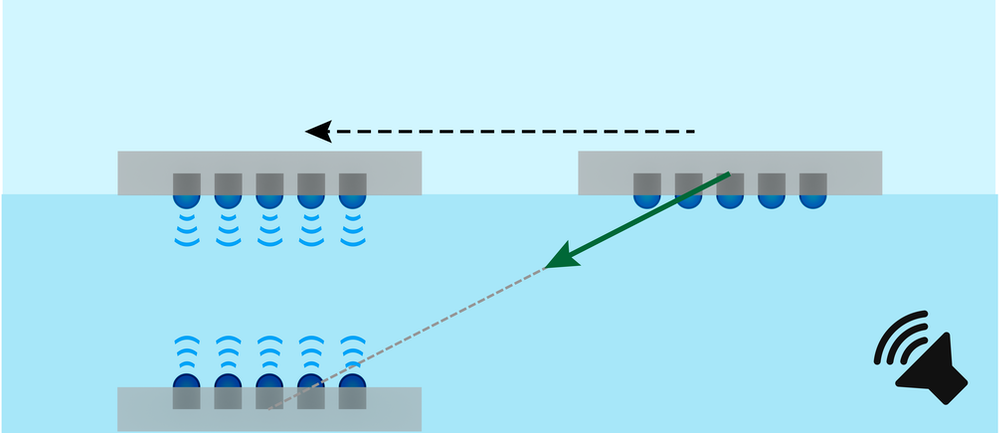Manipulating Objects Using Air Bubbles and Sound Waves
Assembling small components into structures is a fiddly business often encountered in manufacturing, robotics, and bioengineering. Some existing approaches use magnetic, electrical, or optical forces to move and position objects without physical contact. Now a team has shown that acoustic waves can create attractive forces between centimeter-scale objects in water, enabling one such object to be accurately positioned above another [1]. The scheme uses arrays of tiny, vibrating air bubbles that provide the attractive force. This acoustic method requires only simple equipment and could provide a cheap, versatile, and gentle alternative technique for object manipulation.
Researchers are developing techniques that use acoustic waves to position objects such as colloidal particles or biological cells. Attractive forces are produced by the scattering of sound waves from the objects being manipulated. One limitation of this approach, however, is that positioning is more accurate with waves of higher frequency (and thus smaller wavelength), but higher frequencies are also more strongly absorbed and attenuated by many materials.
Athanasios Athanassiadis of the Max Planck Institute for Intelligent Systems in Germany and his coworkers have solved this problem by using sound to excite an attractive force between arrays of air bubbles. When a sound wave vibrates an object, the pressure difference from one side of the object to the other produces an oscillating force that will average to zero over each wave cycle if the object is rigid. But an air bubble in water oscillates significantly in size in response to sound, creating an asymmetry: a higher pressure could appear on the left when the bubble is larger and on the right when the bubble is smaller, say, leading to a net rightward force. If the acoustic wave originates from sound scattering off another bubble, it sets up an attractive force between the two bubbles, called the secondary Bjerknes force.
This force is relatively weak, but Athanassiadis and colleagues figured it might be boosted to a level sufficient for driving the positioning of small objects by covering their surfaces with bubbles. Each individual bubble in a 2D array will then interact with many others on the surface of another nearby object. The researchers calculated that the combined forces for hundreds or thousands of bubbles on each component could approach about a millinewton—stronger than the magnetic force typically possible between small objects of comparable size. Accurate positioning is possible because the minimum acoustic wavelength is set by the size of the microbubbles, not by the objects themselves.
To test out the idea, the team made 1-cm square plates from a rubbery polymer and patterned them with 11 × 11 checkerboard arrays of microscopic cylindrical dimples. Bubbles roughly 300 micrometers across could fit into these cavities like eggs in a carton. When placed in water, the arrays trap microbubbles, which remain securely attached to the water-repelling surfaces.
Athanassiadis and colleagues fixed one plate to the base of a dish filled with about 1 mm of water and let a second plate float above it, with the bubble array face down. An acoustic vibration of wavelength 450 mm applied to the dish excited the attraction between bubbles and caused the floating plate to drift rapidly over to the fixed one and to rotate until it was perfectly aligned, with an accuracy of 14 micrometers.
In a second experiment, the researchers imprinted the plastic plates with an asymmetrical pattern and found that, in this case, the Bjerknes force created a torque that continuously rotated one plate above the other, making it a kind of motor (albeit with the direction of rotation determined randomly). Rotational inertia keeps the top plate spinning indefinitely.
“We expect that the system would be well-suited to any application requiring precise positioning in a fluid environment,” says Athanassiadis. “I am also currently exploring how we can adapt the principle to design actuators for microrobots and whether we can apply similar ideas outside of liquid environments.”
The method is “a simple and original way to activate attraction at a distance between two objects,” says acoustic physicist Philippe Marmottant of Grenoble Alps University in France. “The acoustic forces are much bigger than optical-tweezer forces [produced by a laser beam] and also bigger than magnetic forces when the number of bubbles is more than a hundred.”
“The engineering achievement of this paper is very nice,” says fluid dynamics researcher Detlef Lohse of the University of Twente in the Netherlands. But he cautions that applications might be quite challenging, as bubble arrays are not always very robust. Athanassiadis agrees, saying that bubbles larger than a certain size may break apart when excited strongly by sound. But he is hopeful that “many of these limitations can be overcome by clever design or modifications of [this] approach.”
–Philip Ball
Philip Ball is a freelance science writer in London. His latest book is How Life Works (Picador, 2024).
References
- R. Goyal et al., “Amplification of acoustic forces using microbubble arrays enables manipulation of centimeter-scale objects,” Phys. Rev. Lett. 128, 254502 (2022).





